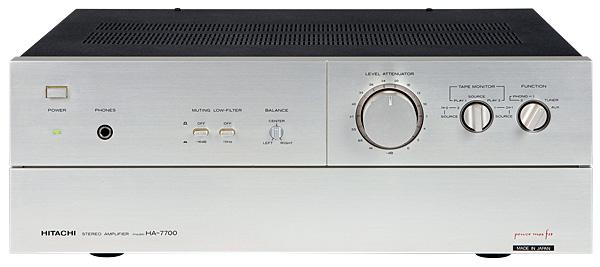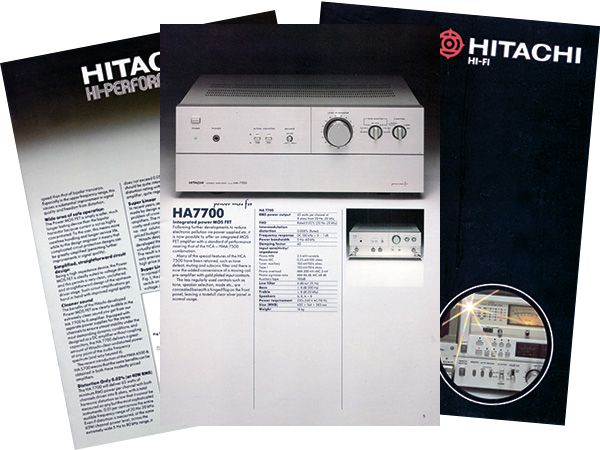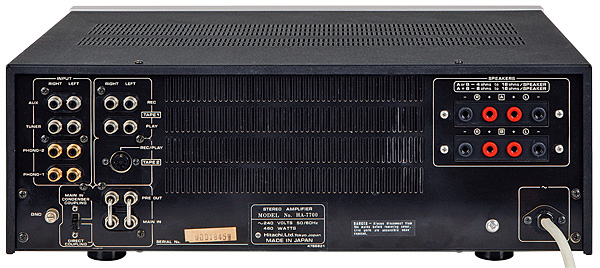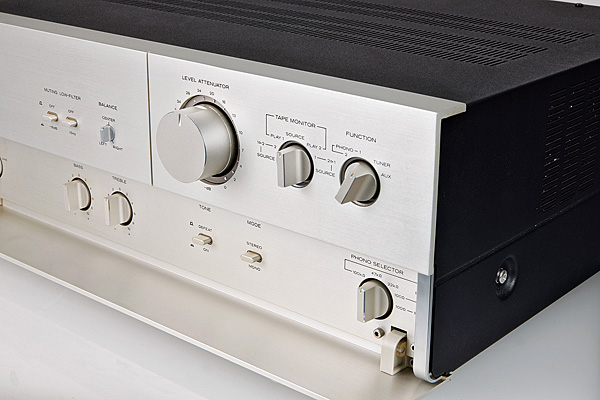Hitachi HA-7700 amplifier

 It wasn't a budget buy, but this late '70s integrated from the masters of the MOSFET spearheaded fresh thinking on amplifier design. But how does it sound today?
It wasn't a budget buy, but this late '70s integrated from the masters of the MOSFET spearheaded fresh thinking on amplifier design. But how does it sound today?
The advantages of using separate pre and power amplifiers over an integrated is a discussion that can still occupy audiophiles for hours. What was almost a necessity in the valve era became less technically significant once transistors were established, a quality solid-state preamp circuit being undemanding in terms of space and power.
These were the arguments put forward by Hitachi when, in 1979, it introduced its HA-7700 integrated amplifier. Claimed to be a synthesis of the previous HCA-7500 preamp and HMA-7500 power amp, the HA-7700 condensed the best parts of both designs into a single, elegantly styled (if still substantial) chassis.

Variable Loading
The HA-7700 boasted all the usual features and refinements found in a typical large Japanese hi-fi amplifier of the period. These included an extensive implementation of DC coupling throughout the signal path, the use of oversized reservoir capacitors in the power supply (4x12,000μF in this case) and a built-in phono stage with gold-plated input sockets offering provision for moving-coil as well as moving-magnet cartridges.
Another facility usually found only among the top ranks of Japanese designs was the option of variable cartridge loading. The values were sensibly chosen at 100kohm, 47kohm and 22kohm for MM types with a fixed 100ohm value for MCs. This contrasted with some designs, notably from Sony, which tended to select values that only matched cartridges from the same manufacturer's own range.
A power amplifier can be usefully described as essentially a modulator for its power supply, a fact that was clearly grasped by Hitachi in the design of theHA-7700. Dual mains transformers were used, one feeding each channel via a dedicated rectifier and reservoir circuit. In addition, an extra winding on each provided one half of the symmetrical supply to the preamplifier, ensuring that balance was maintained throughout. Anti-phase connections were used so that magnetic fields created by the transformers did not interfere with each other.
The Real Deal
It's the power amp itself that is the main area of interest in the HA-7700. This saw the company's own power MOSFET (Metal Oxide Silicon Field Effect Transistor) devices used in its final stage, allowing a circuit to be realised that was powerful, durable and capable of excellent results thanks to the simplicity of its layout.

Hitachi made both the transistors and application notes necessary to build them into practical circuits available throughout the industry, giving rise to a whole range of clones and derivatives, most notably from a number of niche British brands. However, Hitachi's leadership in the field combined with the company's reputation for finish, reliability and value meant that 'the real thing' was always the one to have.
The MOSFET's natural competitor was the V-FET (Vertical Field Effect Transistor). Once favoured by Sony and Yamaha, the V-FET worked well but it proved difficult to build a reliable product it around due to its complex biasing requirements. On the other hand, the MOSFET was exceptionally tough and in the expert hands of Hitachi contributed to perhaps one of the most durable range of hi-fi amplifiers ever to have been marketed.
Being a high-speed device with a wide linear operating region, the MOSFET allowed a useful reduction in harmonic distortion to be achieved. The HA-7700 was specified as giving no more than 0.02% THD at its maximum output of 65W/8ohm (20Hz-20kHz), an impressive result reflected in PM's Lab Report, p123. In addition, MOSFETs are immune to the problem of thermal runaway, which is an ever-present danger with conventional bipolar transistors. This allowed higher levels of bias to be used in the output stages of these Hitachi amplifiers, moving their operation closer to the Class A ideal.
The HA-7700 is therefore a surprisingly hot-running unit, although the ventilation scheme has been arranged so that the waste heat escapes through the rear of the amp rather than the top.

Selling for around £290, the HA-7700 was not a budget option. It was £40 more expensive than the company's HCA-6500/HMA-6500 pre/power combo [HFN Jan '15] of the same year, although the HA-7700 did offer additional features and more power. The smaller, but still excellent, HA-5700 gave away only 15W to the HA-7700 but was a full £100 cheaper, while still retaining the MOSFETs and the MC phono stage. Clearly very good value, this particular model proved to be a strong seller for Hitachi.
For HA-7700 owners wanting a tuner, the FT-8000 at around £220 was the natural choice, but adding a matching cassette deck involved some serious expenditure. The D-5500M was the suggested model, at a sobering £500.
'Modesty' Flap
Visitors to our Hi-Fi Show Live in October 2017 may have noticed an HA-7700 on demonstration as part of our vintage display. In contrast to the other equipment present, the HA-7700 is one of those products that doesn't seem to have aged to any great extent. The 'modesty flap' at the bottom and the vertical division of the upper part of the fascia bring to mind the Hitachi-based Myst G-Ohm amplifiers that appeared a few years later, whose stacked separate units were split along similar lines.


















































